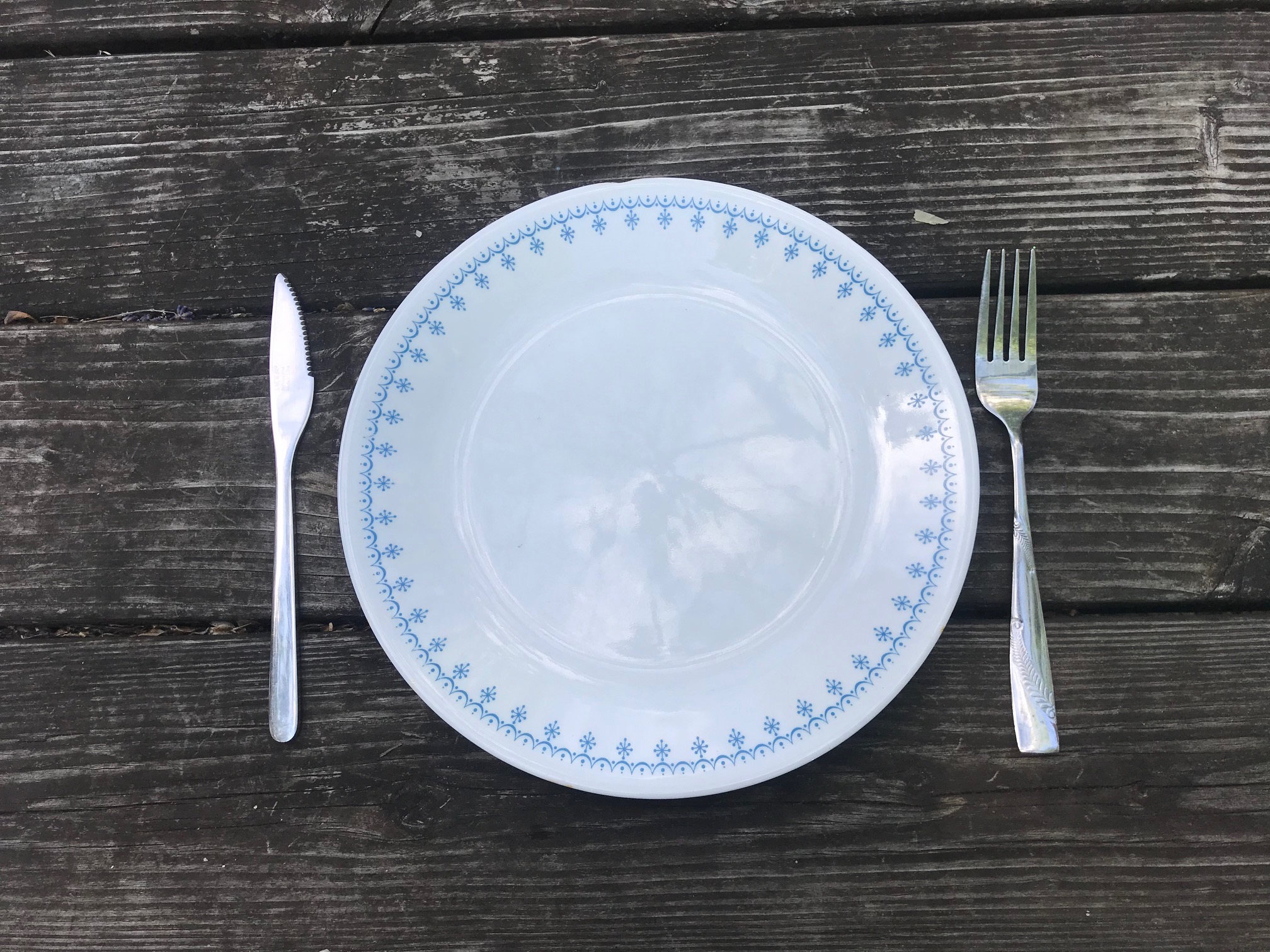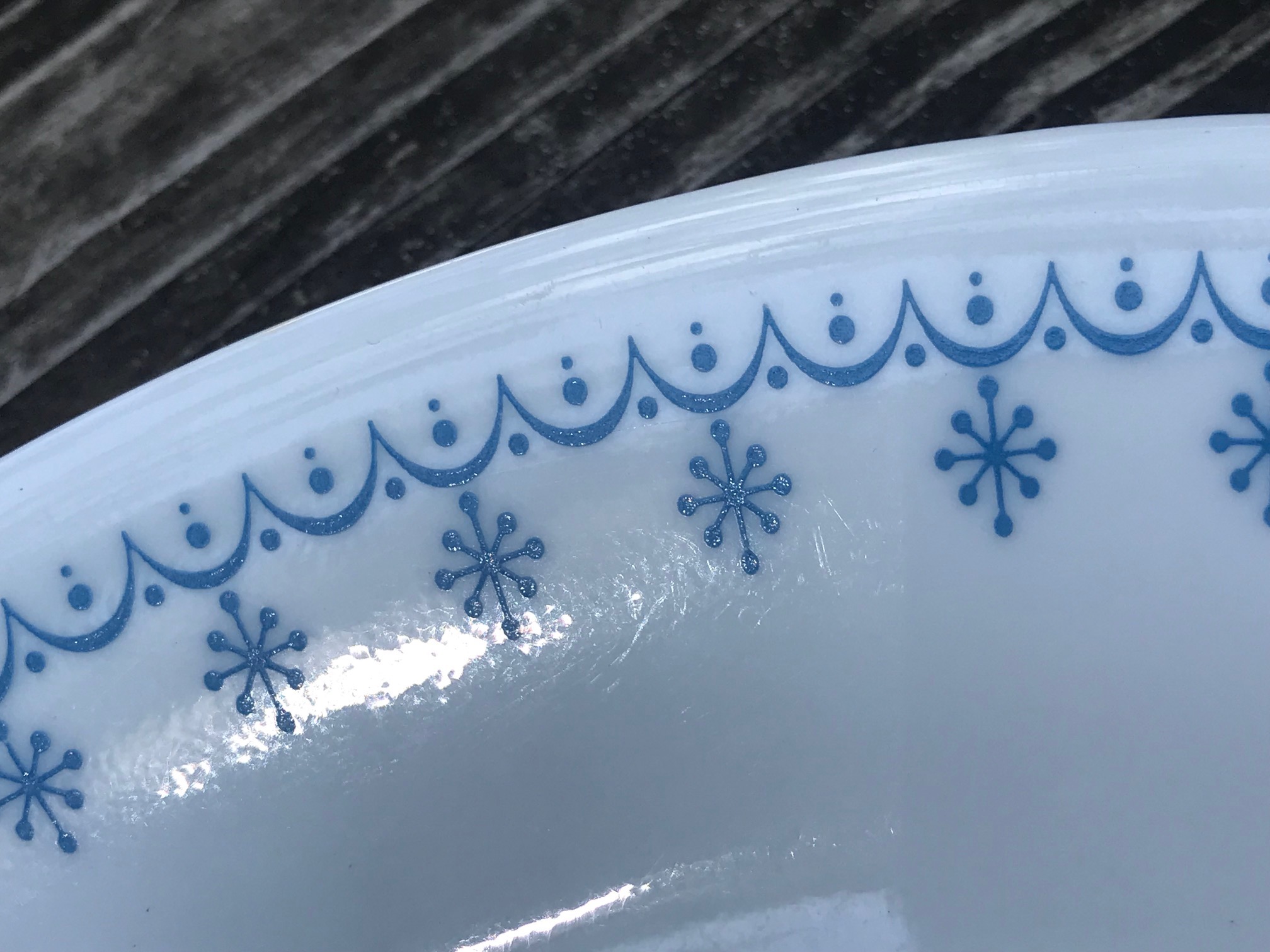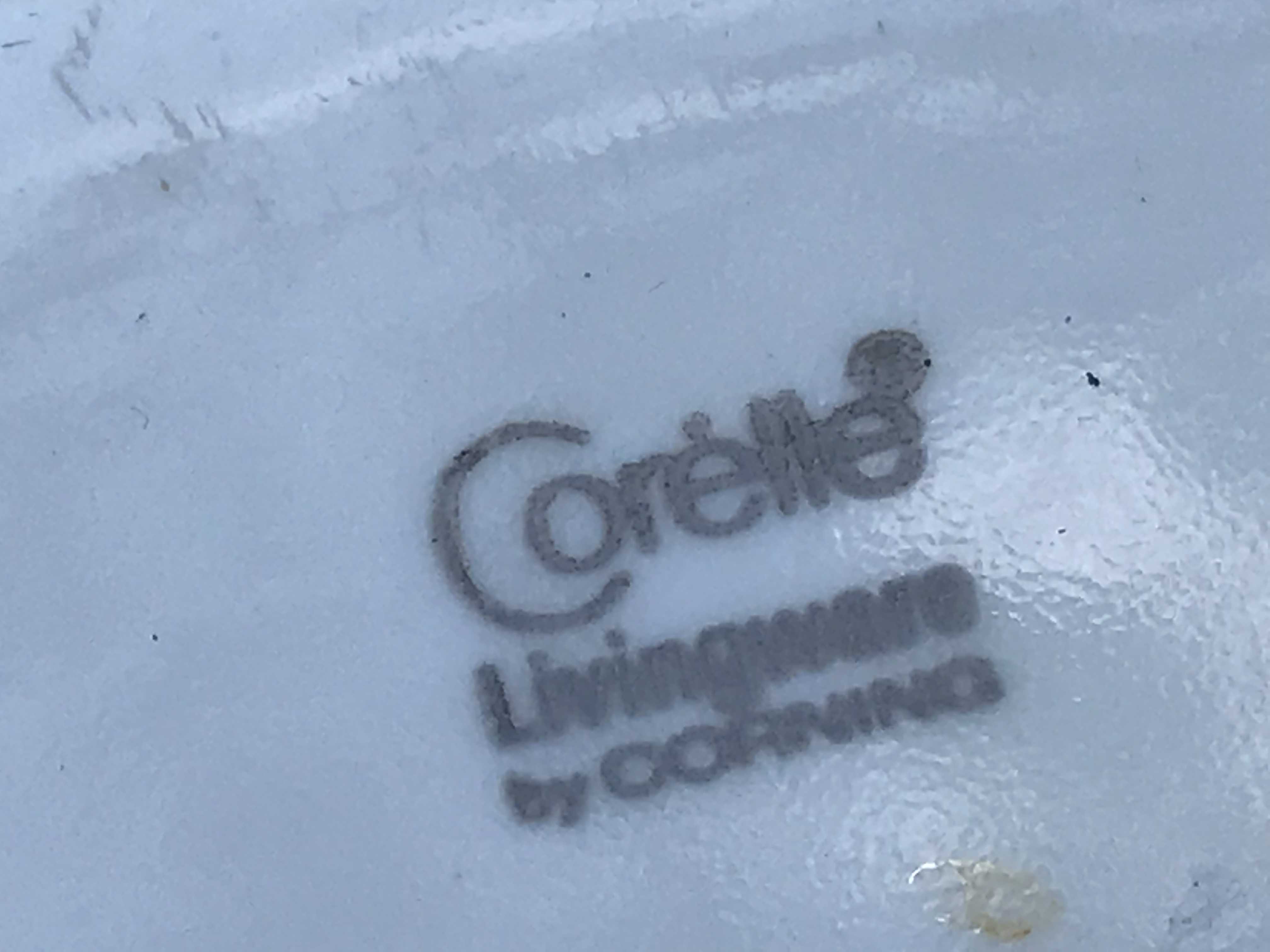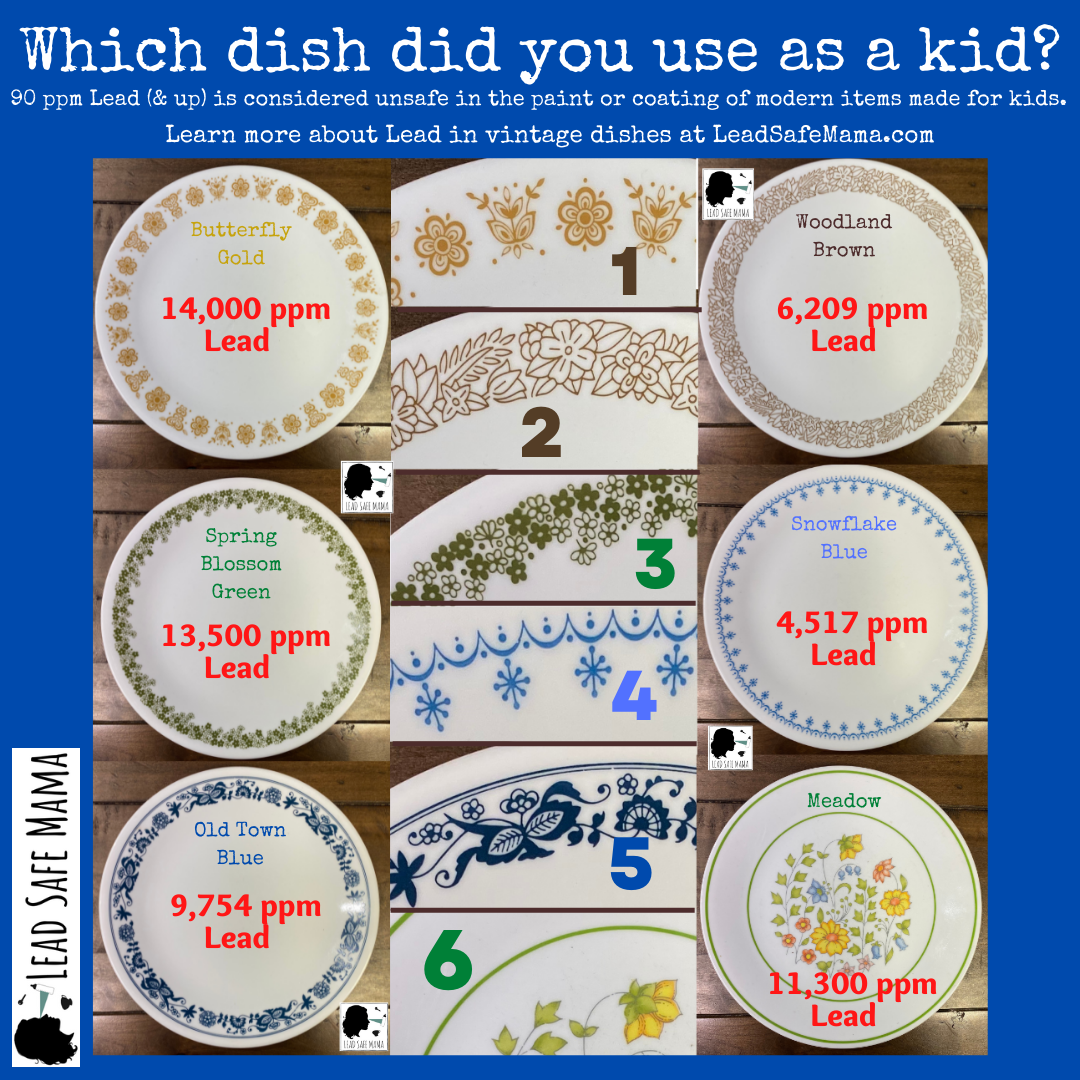Vintage Corelle Blue Snowflake Pattern Plate: 7,823 ppm Lead (90 ppm is unsafe for kids) & 69 ppm Cadmium
For those new to the Lead Safe Mama website:
Tamara Rubin is a multiple-federal-award-winning independent advocate for childhood Lead poisoning prevention and consumer goods safety, and a documentary filmmaker. She is also a mother of Lead-poisoned children (two of her four sons were acutely Lead-poisoned in 2005).
- Tamara owns and runs Lead Safe Mama, LLC — a unique community collaborative woman-owned small business for childhood Lead poisoning prevention and consumer goods safety.
- Since 2009, Tamara has been conducting XRF testing (a scientific testing method) using the exact instrumentation employed by the U.S. Consumer Product Safety Commission to test consumer goods for toxicants (specifically heavy metals — including Lead, Cadmium, Mercury, Antimony, and Arsenic).
- Since July of 2022, the work of Lead Safe Mama, LLC has been responsible for 5 product recalls (FDA and CPSC).
- All test results reported on this website are science-based, accurate, and replicable.
- Items that Lead Safe Mama, LLC reports on are tested multiple times to confirm the results published (for each component tested).
- Recent notable press… There has been too much to mention already in 2024! Please check out our press page to see some of the amazing coverage of our work so far this year!
Originally Published:
June 22, 2019
To see more Corelle pieces that Lead Safe Mama, LLC has tested, click HERE. This article (below) includes the full XRF test results for this vintage “Snowflake Blue” patterned Corelle plate pictured above (the exact year of manufacture is unknown).
When tested with an XRF instrument, the painted decorative border on the food surface of this particular vintage Corelle plate was positive for a very high level of Lead. To see the full XRF readings for this exact plate, scroll down. Note: I don’t know the exact year of manufacture of this piece as this piece was purchased second-hand at GoodWill. If you have information about the year of manufacture (or year range) for this pattern, please comment here on this article. To learn more about XRF testing, click HERE.
Some context for the concern for Lead in dishware
- All United States federal agencies (including EPA, CDC, HUD, USDA, and FDA) agree with the scientifically established fact that there is no safe level of Lead exposure for humans.
- Consistent with the science supporting the issue and as a mother of Lead-poisoned children (children who have significant long-term health issues as a result of being exposed to Lead as babies/ toddlers) I have taken the stance that there is no place for any amount of Lead on our dining tables. None at all.
- Given the potential risks involved, if parents knew their dishes might have Lead in the surface paint or glaze they would (of course) choose a Lead-free alternative.
- I have made it my mission to help inform parents of consumer goods that may be high in Lead (or other toxic heavy metals) so they can make safer (scientifically informed) choices for their families.
It literally just takes a microscopic amount of Lead to poison a child (or any human for that matter) and, as of the moment of publishing this article, there is NO other individual, company, educational institution, or other agency specifically studying the potential impact that eating off of Leaded vintage dishware has on the users (because no corporation stands to benefit financially from such a study). There have, however, been several tangentially relevant studies demonstrating the potential health risks of Lead painted glassware — here’s a link to one such study from England in 2017.
In addition to the fact that there is no safe level of Lead exposure/ that it takes just a microscopic amount of Lead to poison a human, the impact of Lead on our bodies and our health is cumulative. This means that the more Lead we are exposed to, the greater the potential for long-term negative health impacts (you can read more about the symptoms of Lead exposure at this link). Consequently, as consumers we need to err on the side of prudence, and proactively remove all potential sources of Lead exposure from our homes ourselves.
Since Lead exposure pathways include ingestion and inhalation, the logical first/best place to start the process of removing Lead from our homes is to start in our kitchens — with a reasonable first step being to make sure the dishes we eat off of every day with our families are Lead-free.
These particular Corelle-brand dishes tested positive for 7,823 ppm Lead in the blue decorated markings on the food surface of the dish.
For context, to better understand what this level of Lead means: the amount of XRF detectable Lead that is considered toxic in a newly manufactured item “intended for use by children” is anything 90 ppm Lead or higher in the paint, glaze, or coating or an item and anything 100 ppm Lead or higher in the substrate. As a result, were this dish manufactured today, regulators would not (in theory) consider this to be safe for children to use.
HOWEVER, dishes (modern or vintage) are (inexplicably) not considered to be items “intended for use by children,” and thus are not regulated for total Lead content (as detectable with an XRF) in the same way as toys and other similar children’s items (unless they are dishes expressly marketed and sold as “baby dishes” — manufactured expressly for use by children after 2010).
Some additional reading/links that may be of interest
- To read more about the concern for XRF-detectable Lead in dishware, click HERE.
- What should I do with my dishes if they test positive for Lead? Click HERE.
- For a pretty Lead-free & Cadmium-free dishes option, click HERE.*
Full XRF test results for the dish pictured are below the image.
Reading #1) Decorative Edge/ Food Surface (image above):
60-second test
- Lead (Pb): 7,823 +/- 141 ppm
- Cadmium (Cd): 69 +/- 7 ppm
- Tin (Sn): 111 +/- 13 ppm
- Chromium (Cr): 889 +/- 88 ppm
- Zinc (Zn): 42 +/- 14 ppm
- Copper (Cu): 98 +/- 28 ppm
- Iron (Fe): 492 +/- 100 ppm
- Vanadium (V): 105 +/- 27 ppm
- Titanium (Ti): 231 +/- 42 ppm
- Indium (In): 19 +/- 8 ppm
- Zirconium (Zr): 1,899 +/- 42 ppm
- Platinum (Pt): 154 +/- 51 ppm
- Cobalt (Co): 1,743 +/- 111 ppm
- No other metals were detected in consumer goods mode.
Reading #2) Plain White Center of Plate/ Food Surface:
60-second test
- Lead (Pb): non-detect
- Cadmium (Cd): non-detect
- Arsenic (As): non-detect
- Mercury (Hg): non-detect
- Antimony (Sb): non-detect
- Tin (Sn): 99 +/- 14 ppm
- Iron (Fe): 383 +/- 120 ppm
- Vanadium (V): 81 +/- 25 ppm
- Titanium (Ti): 112 +/- 32 ppm
- No other metals were detected in consumer goods mode.
All tests reported on this website were done for at least 60 seconds each (unless otherwise noted), using an XRF instrument. The XRF instrument used in the testing is a Niton XL3T, a scientific instrument specifically designed and intended expressly for testing consumer goods for Lead and other metals. The results are science-based, replicable, and accurate.
Safer Choices for Dishware
The good news is that Lead-free dishes are both inexpensive and readily available/easily found today. The links below include some specific guidelines and information about brands that may be Lead-safe (below 90 ppm Lead) or Lead-free (when tested with an XRF Instrument), but please let the information on these links serve only as a guide for what you might choose (you can often find the same recommended brands available for less at Target and Walmart, just follow the guidelines and stick with the specific recommendations in the links below.
- This page has links to only Lead-free choices for dishes.
- This page has a discussion of different popular brands and whether or not they are likely to be Lead-free.
- This link takes you to a section of this website where you can look up your dishes by brand or pattern (you can also use the search bar on any page of the site to enter keywords at any time).
- This article discusses brands that consistently sell and/or manufacture high Lead dishware (specifically stores and brands you may want to avoid).
- This article has a video sharing how you can efficiently search this website (which currently has over 3,300 articles and pages). The video highlights all the ways you can find Lead-free things here on the website!
To learn more about the concern for Cadmium (Cd) — a known carcinogen — in consumer goods (including dishware), click HERE. XRF detectable Cadmium is considered toxic at levels as low as 40 ppm (and up).
As always, please let me know if you have any questions, I will do my best to answer them personally — although with 1,000,000+ readers here on this website each year, it may take a while! Thank you for reading and for sharing this work!
Tamara Rubin
#LeadSafeMama
*Amazon links are affiliate links. If you purchase something after clicking on one of our affiliate links Lead Safe Mama, LLC may receive a small percentage of what you spend at no extra cost.
The image directly below is the back mark of the vintage Corelle Snowflake Blue dish pictured. Comparing the back marks of dishes is a good way to try to determine if they are of the same vintage (and if they are therefore likely to have a similar level of Lead in the glaze or painted decorated markings).
Please click the image below and then click the “share” button on Facebook to share this information with your friends, families, and communities.
Never Miss an Important Article Again!
Join our Email List














These are my plates, inherited from Grandma when I couldn’t afford anything else. 1970-1976 were years of manufacture.
Thank you for chiming in Jennifer!
Tamara
You are very welcome. We are eating from paper plates temporarily, now. Before I throw these out, would you like any for your lead museum? We have salad plates, dinner plates, savers, and small mugs. I’m happy to send one of each or a piece of your choice. Just let me know. And thank you. I’ve eaten from these plates since birth at my grandmother’s, and every day for the last ten years. I hope my children have not suffered too much :(.
I’ve been eating off these snowflake pattern for 47 years. My family has depression, arthritis, anxiety, my dad was violent at times, my dad just died of cancer. Could these be signs of neurology damage from lead exposure? Can we sue? My parents got these as newly Weds at March AFB BX in 1971.
Those health impacts have all been scientifically studied and linked to Lead exposure unfortunately. Here’s my article about symptoms in adults (with some additional science linked at the bottom for folks to explore):
https://tamararubin.com/2017/01/what-is-the-impact-of-lead-poisoning-in-adults-including-college-age-students/
Of course we are looking at aggregate exposure sources for most people over 24 years old in 2022 – Leaded gas, lead in house paint, and lead in consumer goods (household items) – as well as potential for industrial / occupational / hobby exposures (hunting, fishing, stained glass etc.)
T
My parents have had this set since before I was born in 1978. Mom said early-mid 70’s as well. I ate off of these all my life til I moved out and they are still using them. I am replacing my bone china, that breaks so easily, with plain white correlleware. I’m glad to find out it is safe to use. Out bone chine ones are plain as well.
Link with more info about them. May want to test the coordinating Pyrex pattern as well, if you come across it. My mom has many pieces, but not sure she will give any up.
We received these as bridal shower and wedding gifts in 1975. Unfortunately I have used them everyday since. This is so scary.
I received this set as a wedding gift in May of 1976, and have used them daily ever since!
We received two sets of the Snowflake pattern asa wedding gift in 1973. Been in use ever since.
We purchased our Snowflake Blue CORELLE shortly after being married in 1974. We used them until about 2000, when my mom thought we should have some new stoneware. After too many of them were broken I pulled the Corelle back out, and my Granddaughter took some of the to college!! Now we both need new dishes!!
Note: we never had a dishwasher before so they were still new looking. Now our dishwasher is washing the flowers and the shine off of them. (Maybe using the sanitize cycle too much?)
I received the snowflake blue dishes in January of 1973. I do have 3 serving bowls too. D as nice paint is on the outside only, guessing they are safe to use?
Snowflake pattern blue was manufactured between 1970-1976. We purchased some in 2015.
I purchased approximately 1971. We used until early 80’s after Corelle stopped replacing broken pieces for free, and then snowflake pattern was discontinued. I purchased plain white so I could dress up or down, and easily replace when a piece became broken. I still have several pieces that I keep under the white ones in case we need extras. We have no little ones anymore, so I guess the damage has been done.
We were given the square Pretty Pink Corelle set as a wedding present in 1990.
They have been used daily all these years!
Do you have any info about these??
Thank you!
I don’t know if this helps with the dating, but I was given a set of the Blue Snowflake between 1972 and 1974 as a housewarming gift. I was married in 1974, and this set was in daily use for the entire early years of my marriage, including the childhoods of our two children. The pieces were gradually lost to breakage, and I am going to go in and check to see what I have on hand at the moment. We were and are generally healthy. I can tell you that my set did not have that “Livingware” mark on the bottom. It just had a “Corelle by Corning” imprinted mark. I will see if I have a piece left for a photo for you.
Got 2 sets of the blue plates for my bridal shower in 1975. Have been using them since, along with 8 more in green I got from my mother in late 90s. Also have all the coffee cup saucers that match and cereal bowls and salad plates. Please tell me the bowls are safe, as the blue is only on the outside. Is it just the colors that are unsafe? The white surfaces are safe? I will go buy some nice plain white plates!
We’ve used these forever, inherited from my grandmother and as far as I know we’re all alright? I’ve depression but it was triggered by trauma in 2013 that did me a turn of two years in therapy. Mom still has them and we still use them, so I don’t know if maybe we’re just unconsciously not eating anything that touches the blue or what.